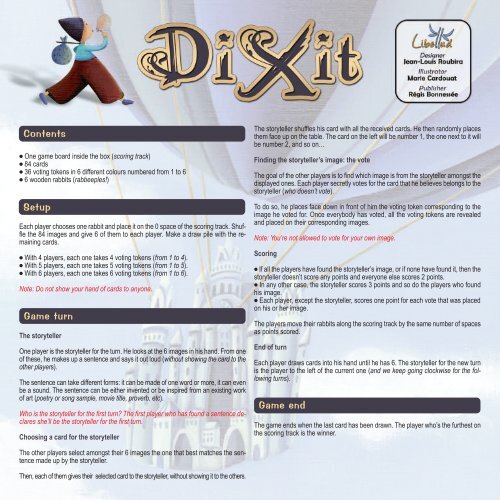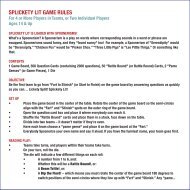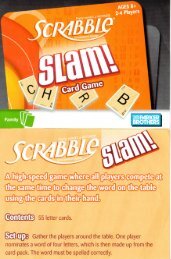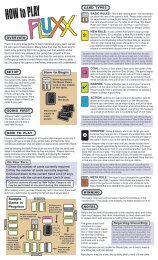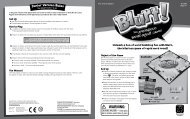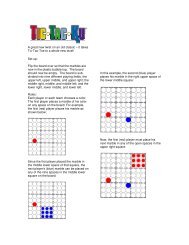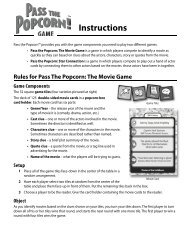Dixit Rules .PDF - Marbles: The Brain Store
Dixit Rules .PDF - Marbles: The Brain Store
Dixit Rules .PDF - Marbles: The Brain Store
You also want an ePaper? Increase the reach of your titles
YUMPU automatically turns print PDFs into web optimized ePapers that Google loves.
Contents<br />
- One game board inside the box (scoring track)<br />
- 84 cards<br />
- 36 voting tokens in 6 different colours numbered from 1 to 6<br />
- 6 wooden rabbits (rabbeeples!)<br />
Setup<br />
Each player chooses one rabbit and place it on the 0 space of the scoring track. Shuffle<br />
the 84 images and give 6 of them to each player. Make a draw pile with the remaining<br />
cards.<br />
- With 4 players, each one takes 4 voting tokens (from 1 to 4).<br />
- With 5 players, each one takes 5 voting tokens (from 1 to 5).<br />
- With 6 players, each one takes 6 voting tokens (from 1 to 6).<br />
Note: Do not show your hand of cards to anyone.<br />
Game turn<br />
<strong>The</strong> storyteller<br />
One player is the storyteller for the turn. He looks at the 6 images in his hand. From one<br />
of these, he makes up a sentence and says it out loud (without showing the card to the<br />
other players).<br />
<strong>The</strong> sentence can take different forms: it can be made of one word or more, it can even<br />
be a sound. <strong>The</strong> sentence can be either invented or be inspired from an existing work<br />
of art (poetry or song sample, movie title, proverb, etc).<br />
Who is the storyteller for the first turn? <strong>The</strong> first player who has found a sentence declares<br />
she’ll be the storyteller for the first turn.<br />
Choosing a card for the storyteller<br />
<strong>The</strong> other players select amongst their 6 images the one that best matches the sentence<br />
made up by the storyteller.<br />
<strong>The</strong>n, each of them gives their selected card to the storyteller, without showing it to the others.<br />
<strong>The</strong> storyteller shuffles his card with all the received cards. He then randomly places<br />
them face up on the table. <strong>The</strong> card on the left will be number 1, the one next to it will<br />
be number 2, and so on…<br />
Finding the storyteller’s image: the vote<br />
<strong>The</strong> goal of the other players is to find which image is from the storyteller amongst the<br />
displayed ones. Each player secretly votes for the card that he believes belongs to the<br />
storyteller (who doesn’t vote).<br />
To do so, he places face down in front of him the voting token corresponding to the<br />
image he voted for. Once everybody has voted, all the voting tokens are revealed<br />
and placed on their corresponding images.<br />
Note: You’re not allowed to vote for your own image.<br />
Scoring<br />
- If all the players have found the storyteller’s image, or if none have found it, then the<br />
storyteller doesn’t score any points and everyone else scores 2 points.<br />
- In any other case, the storyteller scores 3 points and so do the players who found<br />
his image.<br />
- Each player, except the storyteller, scores one point for each vote that was placed<br />
on his or her image.<br />
<strong>The</strong> players move their rabbits along the scoring track by the same number of spaces<br />
as points scored.<br />
End of turn<br />
Each player draws cards into his hand until he has 6. <strong>The</strong> storyteller for the new turn<br />
is the player to the left of the current one (and we keep going clockwise for the following<br />
turns).<br />
Game end<br />
<strong>The</strong> game ends when the last card has been drawn. <strong>The</strong> player who’s the furthest on<br />
the scoring track is the winner.
Example of turn<br />
5 players are around the table: Julien, Mathilde, Nicolas, Léa<br />
and Tom.<br />
Julien is the first player to find a sentence inspired by an image<br />
from his hand.<br />
So, he will start the first turn as the storyteller. <strong>The</strong> sentence he<br />
says to everyone is: « Where is happiness? », referring to the<br />
French movie « Happiness is in the field ».<br />
After listening to the sentence, the other players have to choose from their hand an<br />
image that will best match the sentence provided by Julien.<br />
Léa has those 6 cards in hand :<br />
1 2<br />
Amongst those 6 images, she chooses the 3rd one which is, for her, the closest to<br />
Julien’s sentence « Where is happiness? ». She gives this card to him.<br />
Mathilde, Nicolas and Tom also choose one of their cards and give them to Julien, the<br />
storyteller for this turn.<br />
Julien shuffles his card with the ones he received from the other players and places<br />
them in the middle of the table.<br />
Each player (except the storyteller) is going to vote for the one they think is Julien’s card.<br />
Once everyone has selected their voting token, they reveal them.<br />
3<br />
4 5 6<br />
1 2 3 4 5<br />
Only Léa has found Julien’s card (number 4). So she and Julien score 3 points each.<br />
2 players have voted for Léa’s card (number 1) and so she scores 2 additional points.<br />
Tom scores 1 point as one person has voted for his card (number 3).<br />
At the end of this turn, Léa scores a total of 5 points, Julien 3 points and Tom 1 point;<br />
Mathilde and Nicolas don’t score any point as they couldn’t find Julien’s card, and noone<br />
has voted for their cards.<br />
For the next turn, Tom will be the storyteller as he’s seated to the left of Julien.<br />
Game Tips<br />
If the sentence given by the storyteller describes the image too precisely, all the players<br />
will easily find it and so he won’t score any points.<br />
On the other hand, if his sentence has very little to do with the image, it’s quite likely<br />
that nobody will vote for him, and again he will score no points.<br />
So the challenge for the storyteller is to find a sentence that is neither too descriptive,<br />
nor too abstract, so that there is a chance that only some players find it, but not all.<br />
At the beginning, this can be fairly hard to achieve, but you’ll see that the inspiration<br />
comes more easily after a few turns.<br />
Variants<br />
3 players: each player has 7 cards, instead of 6. Every player except the storyteller<br />
gives 2 cards, instead of one. So we end up with 5 displayed cards to choose from.<br />
Scoring: When only one player has found the storyteller’s card, they both score 4<br />
points, instead of 3.<br />
Mimes or songs: in this variant, the storyteller has the possibility to either sing a<br />
song or some music that could be somehow related to the card, or even mime it. <strong>The</strong><br />
rest of the game stays the same.<br />
Finally, nothing prevents you from mixing the different variants together or creating<br />
some of your own!<br />
Acknowledgments<br />
Jean-Louis Roubira and Régis Bonnessée would like to warmly thank all the people<br />
and organisms that have supported them during this project:<br />
Marie Cardouat, Yolande Albert, Jonas and Noémi Roubira, Christelle and Emmanuelle<br />
Chartier, Sébastien Félix, Michel and Monique Bonnessée, Arnaud Pichon, Claudine and<br />
Hugh Hill-Roubira, Colette Cortey and Benam Mohammadi, Claude and Carmen Roubira,<br />
Jeremy Guetté, Muriel Dhifallah, Pierre, Florence and Thomas Artur, Yves Renou, CROC,<br />
Julie Ser, Valérie Bouchet, the REEL association, David Prieto, Vicente Moreira Rato,<br />
Delirium Ludens Sàrl, Wioletta & Marc Przepiorka, Leonardo Greco, Bastien Lefèvre,<br />
Gavin Wynford-Jones.<br />
Translation : Bastien Lefèvre - Gavin Wynford-Jones


